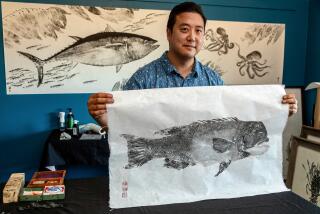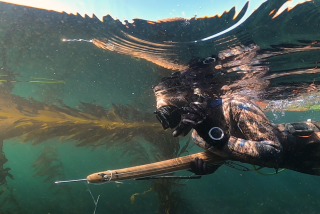Fishing’s Slow, but Tournament Reels Them In
- Share via
KAILUA-KONA, Hawaii — Sometime this afternoon a winner will emerge in the 43rd Hawaiian International Billfish Tournament. One of 22 teams will be immortalized, its name and those of its anglers inscribed on a four-foot wooden marlin on prominent display at King Kamehameha’s Kona Beach Hotel.
But in a way, the winners have already emerged. They did this simply by showing up, with their families and friends, whereupon they quickly caught a bug known around here as the Aloha spirit.
It’s something you don’t see in most tournaments, where the lure of big money transforms fishermen into sharks, out to win at all costs.
In those tournaments--and more are springing up every year--the bug is one that brings out the worst in the competitors.
People become cheats whether they’re cheating or not as paranoia runs as deep as the sparkling sea. It takes a polygraph expert to determine the winners, and even they are often looked at through suspect eyes.
Here at the billfish tournament, an event that in 1959 put the Kona coast on the map as a big-game fishing destination, there is no cash prize. A victory is simply that and having won is reward enough. Competition is fierce but friendly. The honesty displayed by the participants is as refreshing as the trade winds raking gently over the ocean.
Teams turn themselves in for even the smallest of accidental infractions, such as having someone other than the designated angler touching the rod or the line before the fish comes to leader. It happens every year, “And we wouldn’t have it any other way,” said Brooks Morris, 74, who founded the Laguna Niguel Billfish Club in 1979 specifically to have a team to compete in this tournament.
The team has won twice and has reason to be proud: One of its anglers, Gil Kraemer of San Juan Capistrano, in 1986 caught the largest marlin in tournament history, a 1,062-pound blue that stands as the only “grander” ever landed during the event.
“But we come for the friendships we’ve made over the years as much as for the fishing,” Morris added. “Those friendships will last a lifetime.”
This year’s tournament has teams from as far east as Japan, as far south as Australia and as far north as Northern Ireland. It also has several teams from the United States. Four are from Southern California and include the King Harbor Marlin Club, Marina del Rey Anglers and Malibu Marlin Club.
The latter is a two-man team worthy of--although not seeking--recognition despite not having caught a fish through the first three days of fishing.
Like many of the participants, Mark Pfeiffer and Sam Spinello arrived a week early to participate in the tournament’s pro-am event, one that does offer a fairly sizable cash purse as an incentive. On the jet that brought them here they met Mike Redpath, a New York City firefighter honeymooning with wife Jennifer.
Redpath was not on duty when the terrorists struck last Sept. 11, but from the coast he watched in horror as the planes crashed into the World Trade Center buildings. Several in his battalion were killed in the ensuing rescue effort.
Nearly a year later, “He has a wonderful attitude about life,” Pfeiffer said, and during his first trip to Hawaii he asked what it was like to catch a big marlin. On the spot, the two anglers made Redpath an honorary member of the club and invited him to fish with them in the pro-am, giving him the first seat in the fighting chair.
“We both said that we’d rather see him catch his first marlin than win the event, because that only happens once in a person’s lifetime,” Pfeiffer said. “He didn’t catch one, and neither did we, but we gave it our best crack.”
Redpath gave the two anglers patches honoring the names of his fallen co-workers and they now adorn the tournament shirts worn Pfeiffer and Spinello.
It is this kind of spirit that swirls around the tournament.
Pete Maxwell, one of the Laguna Niguel members, came for the fishing but also to spend time on the Big Island with some of the special people in his life. One is his wife, Helen. The others are Karolina and Agnieszka Gochnio, identical twins from Poland who have never had an opportunity to visit such a tropical paradise.
“It is every Polish girl’s dream to come to Hawaii,” said Agnieszka, who has been busy working on her tan and touring the island.
The Maxwells, who have a home nearby, volunteer as English teachers in Poland. They’ve become close with several families there, the Gochnios in particular. The 18-year-old twins were invited to spend their summer vacation here.
Blond and beautiful, they’ve been turning lots of heads during the billfish tournament’s shotgun starts, where they have shown up each morning to send Maxwell off with hugs.
But they’re providing only a small dose of the international flavor so prevalent during the tournament.
Bob Reece, a retired airline company executive, has been coming for 30 years as a member of the Malindi Sea Fishing Club of Kenya. “And I haven’t caught a marlin in 10 years,” he said Thursday morning, “but my son [Glenn] has caught eight [in those 10 years].” Glenn Reece’s 12-year-old son, Brian, is also on board, giving the Kenya team three generations of representation.
Richard Weir is a member of the Queen’s Counsel in Belfast, but the high-profile barrister is also a dedicated member of the Odyssey team from Northern Ireland. With him is his son, Laurence, his nephew Rory Gleadhill and Gleadhill’s girlfriend, Jennifer Rea.
“I first came to Hawaii because I had always heard this was one of the best places in the world to catch big marlin,” said Weir, who has yet to leader one of the really big ones. “I now come because Hawaii and its people I just adore. I love the tournament because it’s not a money tournament. It’s not a pressure situation, although you want to do well and win. There’s still that pride. It’s a clear, clean competition without any worry about money or anything else.”
Weir must really love Hawaii. His team’s routing is from Belfast to London to Los Angeles to Honolulu to Kailua-Kona. “It took us 18 hours to get here,” he said.
That’s nearly as long as the longest battle in tournament history, a 23-hour unsuccessful struggle--by one of the Marina del Rey Anglers team--with a marlin estimated to weigh 1,100 pounds.
Blame It on Meo
Last year’s tournament was one of the most productive in history, with competitors logging 72 catches, including 56 blue marlin, 13 short-nosed spearfish, one striped marlin and two yellowfin tuna, or ahi.
This year’s tournament is shaping up to be one of the least productive. After the first two days of the four-day event only eight blue marlin were tagged and released, none of which met the 300-pound minimum required to be brought aboard and thus worth fewer points. There was a small flurry of activity late Thursday, with a few hookups reported as the deadline approached.
Nobody’s sure why the fishing, which had been phenomenal until about three weeks ago, suddenly dropped off. Some are blaming a developing El Nino for warming surface temperatures to as high as 82 degrees and altering the local currents.
Nothing has helped. Many of the teams have been boarding their vessels carrying bundles of tea leaves for good luck. A few of them tagged and released a small marlin or two, which is better than what could be said about the Laguna Niguel team. Its members invited a reporter along for the first two days--and they were skunked.
It didn’t take long before they started whispering about the so-called “media jinx” and at one point they jokingly--one would presume--threatened to toss the reporter overboard.
Tag and Brag
Organizers can boast of being among the first billfish tournaments to implement a conservation aspect. In 1988 the tournament outlawed gaffing and boating any fish estimated to weigh less than 300 pounds.
Since then, those fish have had to be tagged to be worth any points--a blue marlin tagged and released on 50-pound test, for example, is worth 300 points while one caught on stronger 80-pound test is worth 250 points. A captured fish scores points based on its weight.
The tagging efforts have provided some insight as to the movements of marlin. Tournament founder Peter Fithian said one turned up on the end of a line 2 1/2 years after it was tagged--in the South China Sea. Another was caught a year later in the same area it was initially caught, indicating, perhaps, that individual fish do return to the same places year after year. Another tagged marlin turned up near the Galapagos Islands off Ecuador.
Winding Up
Last year’s top skipper, Randy Parker of the Huntress, is one of an elite few dozen active Kona skippers to have a grander to his credit, and one of an even smaller group to have two fish weighing 1,000 pounds.
While skill was certainly a factor, so was luck. His first involved an angler who insisted on talking to his friends in Florida on a cell phone during a fight that turned tricky on several occasions. On the second, deckhand Boyd Decoito pulled the hook out of the fish’s mouth after getting it to leader.
Parker reached for a gaff and stuck the fish just as it was swimming away. The granders weighed 1,045 and 1,174 pounds, respectively. His brother, Marlin Parker, also has two granders, the largest weighing 1,400 pounds.


